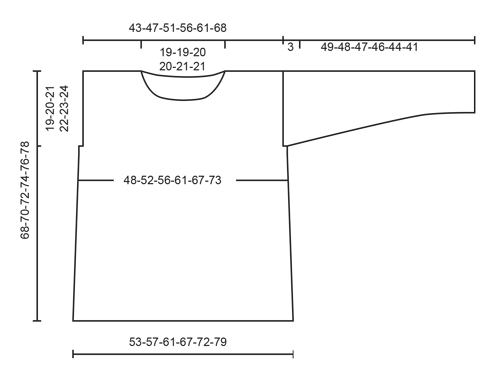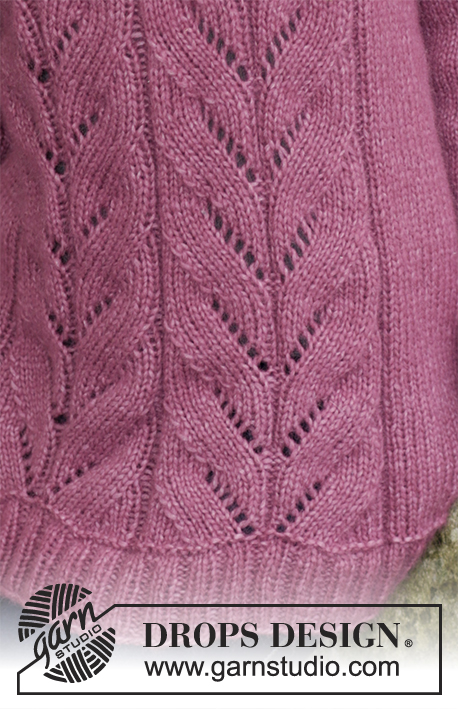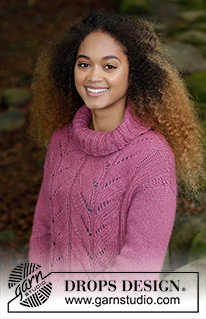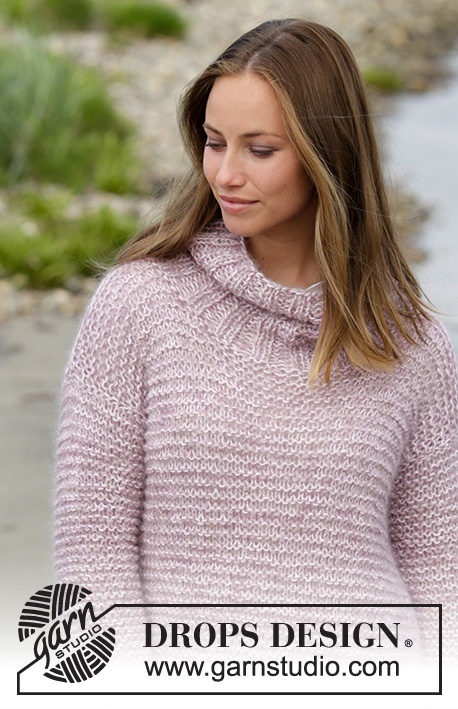Comments / Questions (4)
![]() Ingela Lindgren wrote:
Ingela Lindgren wrote:
Kan inte skriva ut.
26.09.2021 - 10:53
![]() Ingela Lindgren wrote:
Ingela Lindgren wrote:
Kan inte skriva ut
26.09.2021 - 10:51
![]() Nina wrote:
Nina wrote:
Hvorfor skal en felle masker etter vrangborden? Ser dette går igjen i mange av Drops-oppskriftene mens i alle andre oppskrifter skal en øke.....
24.11.2018 - 13:28DROPS Design answered:
Hei Nina. Som du kan se på bildet er vrangborden nederst på genseren like vid som bolen, den snurper seg altså ikke inn nederst. Det er nettopp fordi du feller masker etter vrangborden. En vrangbord er mer elastisk enn glattstrikk og trekker seg derfor mer sammen når den ligger flatt. For at det ikke skal bli viddeforskjell på vrangbord og bole må man ha flere masker i vrangborden. God fornøyelse.
26.11.2018 - 12:05
![]() Jennifer Douglas wrote:
Jennifer Douglas wrote:
This looks lovely. I had trouble with guage last time I used "Air" but this has tempted me to try sgain.
14.07.2017 - 09:53
Lotus#lotussweater |
||||||||||||||||
 |
 |
|||||||||||||||
Knitted jumper with lace pattern and rib. Sizes S - XXXL. The jumper is worked in DROPS Air.
DROPS 179-15 |
||||||||||||||||
|
INFORMATION FOR THE PATTERN: RIDGE/GARTER STITCH (worked in the round): 1 ridge = 2 rounds. Knit 1 round and purl 1 round. RIDGE/GARTER STITCH (worked back and forth): 1 ridge = Knit 2 rows. PATTERN: See diagram A.1. The diagram shows all the rows in the pattern seen from the right side. See diagram for your size. DECREASE TIP (for the side): Start 3 stitches before the marker thread in the side: Knit 2 stitches together, knit 2 stitches (the marker thread sits between these 2 stitches), slip 1 stitch, knit 1 stitch, pass the slipped stitch over the knitted stitch. INCREASE TIP (for mid under the sleeve): Start 1 stitch before the marker thread, make 1 yarn over, knit 2 (the marker thread sits in the middle of these 2 stitches), make 1 yarn over (= 2 stitches increased). On the next round, knit the yarn overs twisted to prevent holes. ---------------------------------------------------------- JUMPER: The piece is worked in the round with circular needle, from the bottom up to the armholes. Then the front and back pie ces are worked back and forth separately. The sleeves are worked in the round with double pointed needles/short circular needle. BODY: Cast on 192-208-220-240-260-284 stitches with circular needle size 5 mm / US 8 and Air. Knit 1 round, then work rib, knit 2/ purl 2. Continue with rib until the piece measures 6 cm / 2⅜". Change to circular needle size 6 mm / US 10 and work 1 RIDGE – see description above, AT THE SAME TIME on the first round of the ridge, decrease 32-36-36-40-44-48 stitches evenly on round = 160-172-184-200-216-236 stitches. Continue working as follows: * Knit 13-16-19-19-23-28, purl 2, A.1 (= 24-24-24-28-28-28 stitches), purl 2, A.1, purl 2, knit 13-16-19-19-23-28 *, work from *-* a total of 2 times. Continue this pattern upwards. REMEMBER THE GAUGE! Insert 2 marker threads in the piece, 1 at the beginning of the round and one after 80-86-92-100-108-118 stitches = the sides. When the piece measures 8 cm / 3⅛" decrease 1 stitch on each side of the marker threads in the sides = 4 stitches decreased, READ DECREASE TIP! Decrease every 12-12-13-13-14-14 cm / 4¾"-4¾"-5"-5"-5½"-5½" a total of 4 times = 144-156-168-184-200-220 stitches. When the piece measures 48-49-50-51-52-53 cm / 19"-19¼"-19¾"-20"-20½"-21" work ridges over 14 stitches in each side (= 7 stitches on each side of the marker threads in the sides). When you have worked 2 ridges over the stitches in the sides, work the next round as follows: bind off the first 4 stitches for the armhole, work 64-70-76-84-92-102 stitches, bind off the next 8 stitches for the armhole (= 4 stitches on each side of the marker threads in the sides), work 64-70-76-84-92-102 stitches, bind off the last 4 stitches. Each part is now finished separately. BACK PIECE: = 64-70-76-84-92-102 stitches. Continue with pattern as before, the 3 outermost stitches in each side are now worked in GARTER STITCH – see description above. When the piece measures 66-68-70-72-74-76 cm / 26"-26¾"-27½"-28⅜"-29⅛"-30" bind off the middle 26-26-28-28-30-30 stitches for the neck and each shoulder is finished separately. Bind off 1 stitch on the next row from the neck = 18-21-23-27-30-35 stitches left on the shoulder. Continue working until the piece measures 68-70-72-74-76-78 cm / 26¾"-27½"-28⅜"-29⅛"-30"-30¾" (the remaining stitches in A.1 are worked in stockinette stitch) and bind off. Work the other shoulder in the same way. FRONT PIECE: = 64-70-76-84-92-102 stitches. Continue with pattern as before, the 3 outermost stitches in each side are now worked in garter stitch. When the piece measures 62-64-66-68-70-72cm / 24½"-25¼"-26"-26¾"-27½"-28⅜" place the middle 20-20-22-22-24-24 stitches on a thread for the neck and each shoulder is finished separately. Continue by binding off for the neck at the beginning of each row from the neck as follows: 2 stitches 1 time and 1 stitch 2 times = 18-21-23-27-30-35 stitches left on the shoulder. Continue working until the piece measures 68-70-72-74-76-78 cm / 26¾"-27½"-28⅜"-29⅛"-30"-30¾" (the remaining stitches in A.1 are worked in stockinette stitch) and bind off. Work the other shoulder in the same way SLEEVE: The sleeve is worked in the round with double pointed needles/circular needle. Cast on 40-40-44-48-52-52 stitches with double pointed needles size 5 mm / US 8 and Air. Knit 1 round, then work rib, knit 2/ purl 2. Work rib for 5 cm / 2", then change to double pointed needles size 6 mm / US 10, work 1 RIDGE, see description above, on the first round of the ridge decrease 6-6-8-10-12-12 stitches evenly on round = 34-34-36-38-40-40 stitches. Continue with stockinette stitch. Insert 1 marker thread at the beginning of the round = mid under the sleeve. Work stockinette stitch in the round. When the piece measures 8-8-8-8-10-9 cm / 3"-3"-3"-3"-4"-3½" increase 2 stitches mid under the sleeve – READ INCREASE TIP. Increase in this way every 3½-3-2½-2½-2-2 cm / 1¼"-1⅛"-⅞"-⅞"-¾"-¾" a total of 12-13-14-14-15-16 times = 58-60-64-66-70-72 stitches. When the piece measures 49-48-47-46-44-41 cm / 19¼"-19"-18½"-18"-17¼"-16" (shorter measurements in larger sizes because of the shoulder width), bind off the middle 6 stitches under the sleeve and the sleeve cap is then worked back and forth on circular needle. Work stockinette stitch and bind off at the beginning of each row in each side as follows: 3 stitches 3 times = 34-36-40-42-46-48 stitches. The sleeve measures approx. 52-51-50-48-47-44 cm / 20½"-20"-19¾"-19"-18½"-17¼". Bind off the remaining stitches. Work another sleeve in the same way. ASSEMBLY: Sew the shoulder seams. Sew in the sleeves. NECK: The neck is worked in the round with short circular needle. Knit up approx. 80 - 100 stitches (including the stitches on the thread and the number of stitches divisible by 4) with short circular needle size 5 mm / US 8 and Air. Work 2 ridges, then work rib, knit 2/ purl 2. Work rib until the neck measures 13 cm / 5", bind off with knit over knit and purl over purl. |
||||||||||||||||
Diagram explanations |
||||||||||||||||
|
||||||||||||||||

|
||||||||||||||||

|
||||||||||||||||
Have you finished this pattern?Tag your pictures with #dropspattern #lotussweater or submit them to the #dropsfan gallery. Do you need help with this pattern?You'll find 32 tutorial videos, a Comments/Questions area and more by visiting the pattern on garnstudio.com. © 1982-2025 DROPS Design A/S. We reserve all rights. This document, including all its sub-sections, has copyrights. Read more about what you can do with our patterns at the bottom of each pattern on our site. |
||||||||||||||||
















































































Post a comment to pattern DROPS 179-15
We would love to hear what you have to say about this pattern!
If you want to leave a question, please make sure you select the correct category in the form below, to speed up the answering process. Required fields are marked *.